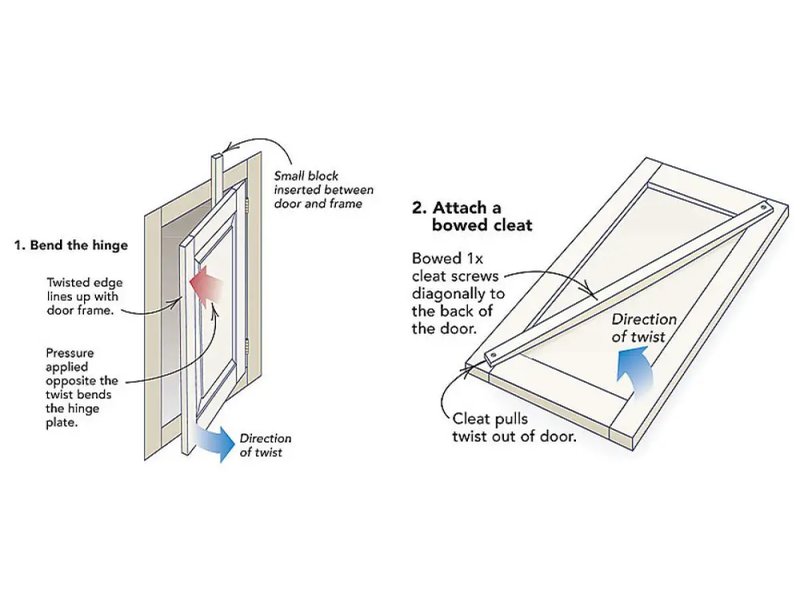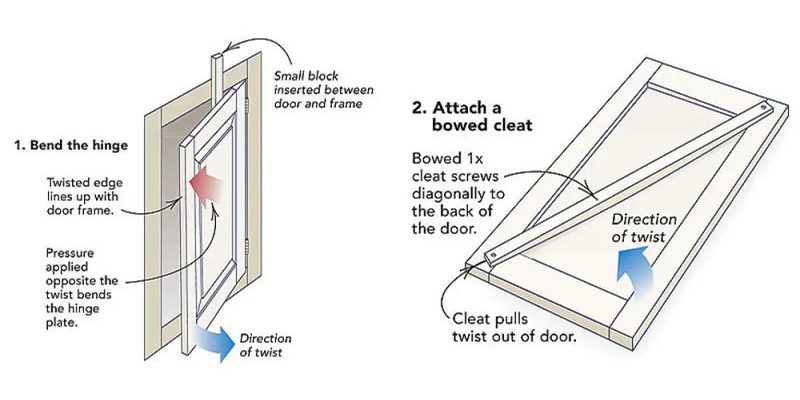
Let’s dive into what causes these pesky warps and how to troubleshoot them without needing a degree in home repair. You might be staring at that door wondering if you need a hammer, a saw, or just some good ol’ elbow grease. I’ll lay out some practical steps to help you understand and tackle the issue, so you can get that door back on track.
Understanding Door Frame Warps
A door frame warp usually happens when the wood absorbs moisture or when it dries out unevenly. Imagine a sponge soaking up water; it gets bigger and swells. When wood does the same, it can twist, bend, or bow. This can lead to problems, especially if your hardware, like hinges and locks, is feeling the impact.
There are two main types of warping: cupping and bowing. Cupping means the edges of the frame curve upward, while bowing means the frame bends inward or outward. Both types can make your door fit poorly, leading to issues with closing or locking.
Why does this matter? Well, a warped door frame can not only be a nuisance but can also lead to increased energy bills if air leaks through. Plus, it can make your home feel less secure.
Identifying the Type of Warp
To tackle a warped door frame, you first need to identify what kind of warp you’re dealing with. Here’s how to check:
1. Visual Inspection: Look closely at the frame. Are there noticeable gaps between the door and the frame? Is there an uneven gap between the top and bottom?
2. Use a Level: Grab a level from your toolbox or borrow one from a neighbor. Place it against the frame. If the bubble in the level isn’t centered, you’ve found yourself a warped door frame.
3. Measure the Gaps: Use a tape measure to check the gaps along the door’s edges. If one side has a larger gap than the other, it indicates warping.
Identifying the specific type of warp helps in determining your next steps. Once you know what you’re up against, you can effectively troubleshoot and remedy the situation.
Common Causes of Warp
So, what causes a door frame to warp, anyway? Here are a few usual suspects:
– Humidity and Moisture: This is the main culprit. Wood is porous, meaning it absorbs moisture. If the humidity levels rise too much, your frame could swell and warp.
– Temperature Fluctuations: Extreme temperature changes can also affect wood. In the winter, for instance, a sudden drop in temperature can cause the wood to shrink.
– Poor Installation: If the door frame wasn’t installed correctly in the first place, it might have problems right from the start. Uneven framing or lack of proper support can lead to warping over time.
– Aging: As wood ages, it can lose its integrity and warp, especially if not maintained properly.
Understanding these causes can help you prevent future warping issues. It’s always better to be proactive than reactive!
DIY Fixes for a Warped Door Frame
If you’re ready to tackle that warped door frame, here are a few DIY fixes you can try:
1. Adjust the Hinges: Sometimes, simply adjusting or tightening the hinges can fix minor warping issues. If one side of the door is sagging, adding a shim behind the hinge can help lift it back into place.
2. Add Shims: If the frame is bowed, you can use shims to fill gaps. Place them between the door frame and the wall to create a flush fit.
3. Moisture Control: If humidity is the issue, consider using a dehumidifier. This might not fix the current warp, but it can help prevent further issues down the line.
4. Sanding and Refinishing: For minor warping, light sanding and refinishing can help. Use sandpaper to smooth out the uneven areas and then apply a sealant or paint to protect the wood.
Taking on these fixes can feel a bit daunting, but with some patience and the right tools, you can make a noticeable difference.
When to Call in the Pros
Sometimes, despite your best efforts, the warp might be too severe for DIY fixes. Here’s when you should consider bringing in a professional:
– Structural Concerns: If the door frame is part of a larger structural issue in your home, you’ll want an expert to evaluate the situation.
– Extensive Damage: If the wood is rotting or severely warped, it’s likely better to replace the entire frame than try to fix it.
– Safety Risks: If your door won’t close properly or poses a security risk, you shouldn’t wait to get help.
Hiring a professional can feel like a hassle, but sometimes it’s the best way to ensure a long-lasting resolution.
Preventing Future Warping
After troubleshooting, you probably don’t want to deal with warped door frames again. Here are some preventative measures:
– Control Humidity Levels: Use a dehumidifier during humid summer months to keep moisture at bay.
– Regular Maintenance: Check your frames regularly for signs of wear or warping. Addressing minor issues before they become big problems can save you a lot of stress down the road.
– Proper Installation: If you’re replacing or installing new frames, ensure they’re correctly fitted and supported. A well-installed frame is less likely to warp.
– Seal and Finish: Always seal and finish wood with a good quality product to protect it from moisture and temperature changes.
Staying on top of maintenance can significantly reduce the chances of dealing with a warped door frame in the future.
A warped door frame might seem like a small issue, but it can lead to bigger headaches if left unattended. By understanding what causes warping and knowing how to troubleshoot and fix it, you can keep your doors functioning well and your home secure. Whether you opt for some DIY fixes or call a pro, tackling this issue will enhance your living space and give you peace of mind.
Remember, every little bit of maintenance helps. A little attention today can save you a lot of time and frustration tomorrow!
